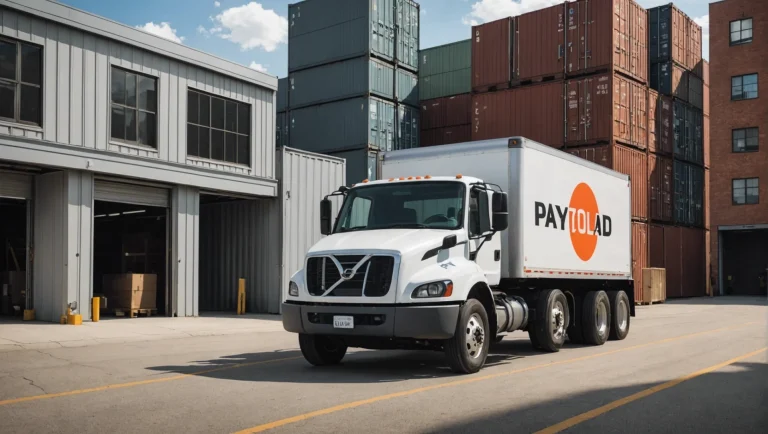Every year, improper payload calculations cost businesses millions in fines, delays, and lost goods.
Struggling to calculate your payload capacity? You’re not alone.
In this guide, you’ll master the essentials to avoid those costly mistakes.
We’ll break down simple formulas and practical steps.
Say goodbye to confusion and hello to efficiency!

Save 80% of delivery management time
We handle everything:
- Dedicated operations manager
- Real-time tracking dashboard
- Automated customer notifications
- Urgent issue resolution
How to Calculate Your Payload Capacity: A Step-by-Step Guide
Step 1: Understand Gross Vehicle Weight Rating (GVWR)
GVWR signifies the maximum total weight a vehicle can handle safely, including its weight plus passengers, cargo, and fuel. This vital figure is often found on the manufacturer’s plate, usually located on the driver’s door frame or near the dashboard.
Why GVWR Matters
The GVWR sets the vehicle’s limit, governing safety and performance. Exceeding this limit can result in decreased braking efficiency and increased wear on tires and suspension. Regular driving at or near the GVWR could also void warranties and insurance coverage, making it a key figure for fleet managers to consider. Enhance your fleet’s efficiency and safeguard your investment by implementing a just-in-time delivery approach, ensuring vehicles operate within their GVWR and maintain optimal performance and safety standards.
Step 2: Determine the Curb Weight of Your Vehicle
The curb weight of a vehicle includes all standard equipment, oils, and a full fuel tank but excludes passengers and cargo. This value provides a baseline to start calculating a truck’s payload capacity refers well.
Finding Curb Weight Information
Curb weight is often listed in the vehicle owner’s manual or on the certification label. If unavailable, you might need to weigh the vehicle while it’s empty using a certified scale. Knowing the curb weight is crucial because it subtracts from the GVWR to give you the payload capacity.
Step 3: Calculate the ‘s and Truck’s Payload Capacity
Calculating the payload capacity becomes straightforward now that you have both the GVWR and curb and gross combined vehicle weight. Deduct the curb weight from the GVWR to find out how much additional weight your vehicle can safely manage. Understanding how much weight your vehicle can carry is essential for effective load planning and distribution, much like anticipating product demand is vital for preparing supply chains.
📊 Basic Formula
Payload Capacity = GVWR – Curb Weight
For instance, if a vehicle has a maximum payload capacity with a GVWR of 7,000 lbs and a curb weight of 4,500 lbs, the payload capacity would be:
Payload Capacity = 7,000 lbs – 4,500 lbs = 2,500 lbs
Hope you find this more engaging! 😃🚚📏
Step 4: Consider Additional Factors
Additional factors can influence the actual payload capacity. These include passengers, fuel, and any optional equipment added to the vehicle. Each of these needs to be factored into the total weight calculation to avoid overloading.
Accounting for Passengers and Cargo
Passengers and cargo add significant weight and can vary greatly. Calculate their impact by estimating the total weight of all passengers and equipment. Remember, even small items add up.
Other Considerations
Aftermarket modifications can change both curb weight and payload capacity.
Regularly check tire pressure and vehicle condition when operating near maximum payload.
Ensure distributions of weight are even for stability and performance.
Common Mistakes to Avoid When Calculating Payload Capacity
Overlooking the Weight of Passengers and Fuel
Payload capacity isn’t just about how much your vehicle or truck can carry in the back. Passenger weight and fuel play crucial roles too. Many business owners make the mistake of only considering the cargo and forgetting the weight of people and full fuel tanks. This oversight can lead to overloading, which is unsafe and illegal. Understanding how payload capacity impacts vehicle performance can optimize outbound logistics, ensuring goods are delivered safely and efficiently.
Real-World Impact
Let’s break down why it matters. Imagine you’re running a small delivery service. Your vehicle has a payload capacity of 1,500 pounds. Your delivery team consists of two people weighing a total of 350 pounds, and a full tank of fuel adds another 150. That leaves you with only 1,000 pounds for your cargo — not the full 1,500 you might have assumed.
Ignoring Aftermarket Modifications
Many business owners customize their vehicles to suit their needs better. While these mods can be beneficial, they often alter the vehicle’s weight and balance. Failing to account for these changes can drastically affect payload calculations.
Suspension and Tires
Upgraded suspensions and heavy-duty tires often weigh more than their factory counterparts. These modifications can improve how much weight your vehicle can safely handle but using standard payload calculations without adjustment could skew the numbers. Explore how the principles of just-in-time manufacturing might influence your approach to vehicular modifications, ensuring optimal performance without unnecessary strain.
Additional Equipment
Think about extra storage racks or mounted equipment. Each aftermarket addition increases the vehicle’s weight, reducing your payload capacity. Even small changes add up, potentially leading you to overload your vehicle unintentionally. Explore how mastering efficient outbound logistics practices can help manage vehicle payloads effectively and enhance shipping efficiency.
Misinterpreting Manufacturer Specifications
One of the most common pitfalls is misunderstanding the specifications provided towing package by the manufacturer. Terms like Gross Vehicle Weight Rating (GVWR) and Gross Axle Weight Rating (GAWR) can be confusing. Misinterpreting these values often leads directly to payload errors.
Understanding the Jargon
GVWR is the maximum allowable weight of the vehicle, including all cargo, passengers, and fuel. GAWR, on the other hand, is the maximum load your vehicle’s axles can handle. Many mistake these as allowances for the payload alone, which is incorrect and dangerous.
Verifying Specifications
Always cross-reference the manufacturer’s specifications with real-world conditions. It’s also useful to consult additional resources or professionals to make sure you’re interpreting these specs correctly.
By avoiding these common mistakes, you set the groundwork for safer and more efficient operations. In today’s fast-paced world, businesses are increasingly turning to solutions that enhance their delivery efficiency. One option worth considering is Metrobi’s revamped approach to logistics, which includes their tailored Seattle same-day delivery service. This offering not only ensures timely deliveries but also helps businesses maintain compliance with payload regulations, creating a win-win scenario for operational efficiency and customer satisfaction.
Tools and Resources for Accurate Payload Calculation
Online Payload Calculators
Online truck payload calculators are essential tools for business owners who need quick, reliable results. These digital tools simplify complex calculations by asking for key inputs like vehicle weight, cargo weight, and axle load distribution. Once the data is input, the calculator provides an immediate payload capacity estimate.
Benefits of Online Payload Calculators
Using an online payload calculator can save time and minimize errors. Manual calculations often lead to mistakes, especially when dealing with intricate variables. An online tool reduces that risk by automating the process. Many of these calculators are continually updated with the latest vehicle specs, making them highly reliable.
Popular Online Payload Calculators
Several high-quality payload calculators are available online. Examples include tools from major vehicle manufacturers, logistics websites, and specialized third-party providers. Look for reviews and recommendations to find one that fits your needs best.
Vehicle Scales
Vehicle scales offer another level of accuracy, providing precise measurements essential for payload calculations. These scales come in multiple formats, including portable, onboard, and fixed options.
Types of Vehicle Scales
Portable scales are convenient for quick checks and can be moved from one site to another. Onboard scales are integrated into the vehicle, providing real-time data and eliminating the need for separate equipment. Fixed scales, often found at logistics hubs, deliver the most precise measurements but are less flexible due to their immobility.
Accuracy and Efficiency
Vehicle scales offer an incredibly high level of accuracy, often to within a few pounds. This is especially important for businesses that face stringent compliance regulations or need to monitor cargo closely. While scales require an initial investment, the long-term benefits of accuracy and safety can outweigh the costs.
Professional Services
For businesses with complex payload needs, professional services can provide tailored solutions. These services range from consulting firms specializing in payload calculations to technicians offering on-site evaluations.
Expert Consulting
Hiring a professional consulting service offers in-depth expertise. Consultants use advanced equipment and methodologies to provide a comprehensive analysis of your payload needs. They also offer actionable recommendations to optimize your operations and ensure you’re always within safety guidelines.
On-Site Evaluations
Another option is to bring in specialized technicians for on-site evaluations. These pros can conduct real-time measurements, evaluate the payload distribution, and suggest immediate adjustments. This hands-on approach significantly reduces the risk of incorrect calculations and inefficiencies.
Prepared with these tools and resources, you’re well-equipped to ensure your payload calculations are accurate, thereby optimizing your operations and minimizing risk.
Why Knowing Your Payload Capacity is Crucial for Business Owners
Safety Concerns
Understanding your payload capacity is fundamental to keeping everyone safe. An overloaded vehicle poses significant safety risks, including reduced braking efficiency, compromised handling, and increased likelihood of tire failures. When a vehicle carries more than its intended payload, the extra weight can stress key mechanical components, leading to premature wear or catastrophic failure.
Safety is not just about avoiding accidents on the road; it also extends to protecting your employees and your cargo. Ensuring you are within your vehicle’s recommended limits can prevent injuries and minimize the risk of costly damage to goods.
Braking and Handling
When a vehicle is overloaded, its braking system must work harder to stop the increased mass. This added strain not only extends stopping distances but can also lead to brake fade, where the braking components overheat and lose effectiveness. Similarly, the vehicle’s handling becomes less predictable as the suspension system struggles to manage the extra weight, increasing the risk of losing control, especially in emergency maneuvers.
Tire Safety
Tires are designed to support a specific load. Exceeding this limit puts additional stress on them, increasing the likelihood of a blowout. A sudden tire failure at high speed can lead to severe accidents. Regularly checking that your loads are within the prescribed limits can save both lives and money.
Legal Implications
Failing to adhere to payload capacity regulations can lead to serious legal consequences. Authorities routinely perform weight checks on commercial vehicles, and exceeding weight limits can result in hefty fines or even the suspension of your operating license.
Legal issues don’t stop at fines; non-compliance can lead to more significant problems, such as lawsuits. If an overloaded vehicle gets into an accident, your company could be found liable for damages, especially if it’s shown that overloading was a contributing factor.
Regulatory Compliance
Different regions have specific regulations regarding commercial vehicle weights. Knowing your payload capacity helps you stay compliant with laws and avoid penalties. For instance, many jurisdictions enforce strict limits on vehicle weight to protect road infrastructure. Violating these regulations can result in fines sometimes amounting to thousands of dollars.
Operational Efficiency
Accurately calculating and adhering to your payload capacity can significantly enhance your operational efficiency. Overloading a vehicle can lead to more frequent breakdowns and higher maintenance costs, resulting in increased downtime that disrupts your workflow. Boost your CSA scores and enhance safety by ensuring your vehicles are not overloaded—discover effective strategies to maintain optimal payload capacity and steer clear of penalties.
Additionally, partnering with a reliable service like courier services in Atlanta can optimize your logistics by ensuring that packages are delivered efficiently while keeping within payload limits.
Sticking to recommended payload limits ensures that your vehicles run more efficiently and last longer. This reliability can translate into more predictable and timely deliveries, which can improve customer satisfaction and boost your business reputation.
Fuel Economy
When a vehicle operates within its recommended payload limits, its engine doesn’t have to work as hard, resulting in better fuel efficiency. Overloading can decrease miles per gallon, inflating your fuel costs. Lowering your fuel expenses can have a meaningful impact on your bottom line, especially over a large fleet.
Maintenance Savings
Vehicles carrying excessive weight experience higher levels of wear and tear. This can lead to increased maintenance costs. Components like the suspension, transmission, and brakes are particularly susceptible. Regularly overloading your vehicles can significantly shorten their lifespan, necessitating costly repairs or replacements sooner than anticipated.
By adhering to payload limits, you not only maintain the safety and legality of your operations but also improve your overall efficiency and profitability. This strategic approach can give you a competitive edge, making your business more resilient and successful. Additionally, partnering with a reliable service like our Newark courier service can optimize your logistics operations, ensuring packages are delivered efficiently while keeping within your vehicle’s payload limits.
Understanding Key Terms Related to Payload Capacity
Gross Vehicle Weight Rating (GVWR)
Gross Vehicle Weight Rating (GVWR) is the maximum permissible weight of a vehicle when fully loaded, including the vehicle’s weight, passengers, cargo, and fuel. Understanding GVWR is crucial because operating a vehicle beyond this limit can lead to safety issues and potential legal penalties. The GVWR is usually specified by the vehicle manufacturer and is a critical factor in ensuring the safe operation of the vehicle. Recognizing the Gross Vehicle Weight Rating (GVWR) is especially vital in the realm of cold chain logistics, ensuring the safety and efficiency of transporting temperature-sensitive goods.
Importance of GVWR
Knowing your vehicle’s GVWR helps you avoid overloading, which can strain the engine, braking system, and suspension, resulting in increased wear and tear. Overloading also makes the vehicle harder to control, posing risks to drivers and other road users. Additionally, exceeding the GVWR can void warranties and insurance policies, leading to costly repairs and liabilities.
Curb Weight
Curb weight refers to the weight of an empty vehicle with standard equipment, all necessary operating consumables (like engine oil and coolant), and a full tank of fuel, but without passengers or cargo. This baseline measurement is essential for calculating other weight metrics, such as payload capacity and towing capacity.
Differentiating Curb Weight from Other Metrics
Unlike GVWR, curb weight does not account for additional cargo or passengers. Also, it’s distinct from the gross vehicle weight (GVW), which fluctuates as you load and unload the vehicle—knowing the curb weight aids in understanding how much additional weight the vehicle can safely carry or tow. Understand the pivotal role of curb weight in enhancing logistics operations outbound, ensuring vehicles operate within safe weight limits for cargo and delivery efficiency.
Gross Combined Weight Rating (GCWR)
Gross Combined Weight Rating (GCWR) is the total allowable weight of a vehicle, including its loaded trailer. GCWR is crucial for businesses involved in transporting heavy goods, as it ensures the maximum combined weight does not exceed safe operational limits. The manufacturer provides the GCWR, factoring in the limitations of the engine, transmission, and braking systems.
Knowing the GCWR helps business owners determine if their current vehicle setup can handle specific hauling tasks. Overlooking this metric can lead to overloading, which compromises vehicle performance and safety. Ensure that both your vehicle and trailer, when fully loaded, remain within the GCWR to avoid mechanical failures and accidents.
Towing Capacity
Towing capacity is the maximum weight a vehicle can tow safely as specified by the manufacturer. This metric is vital for businesses that need to move heavy equipment, trailers, or other vehicles. Towing beyond the recommended capacity can cause severe damage to your vehicle’s engine and transmission, and jeopardize road safety.
Calculating Towing Capacity
To find out a vehicle’s towing capacity, subtract the curb weight and any additional cargo weight from the GCWR. For example, if the GCWR is 15,000 pounds and the vehicle’s curb weight is 7,000 pounds, the towing capacity is 8,000 pounds. Always consult the manufacturer’s specifications and take into account any additional gear or modifications that might affect the truck’s towing capacity or limits.
Payload vs. Towing Capacity
Payload and towing capacity are often confused but refer to different aspects of a vehicle’s carrying ability. Payload capacity is the total weight a vehicle can carry in its cabin and cargo area, including passengers. Towing capacity is specifically about how much weight the vehicle can pull. Understanding the distinction is essential for effectively managing loads and ensuring road safety. Can adopting sustainable transportation methods enhance your vehicle’s efficiency and load management? Explore the benefits of environmentally friendly hauling solutions.
Comparing Payload and Towing Capacity
Payload capacity is calculated by subtracting the truck’s curb weight from the GVWR. For instance, if a vehicle has a GVWR of 10,000 pounds and a curb weight of 6,000 pounds, its payload capacity is 4,000 pounds. Conversely, towing capacity focuses on the trailer and its contents, not the vehicle’s internal load. Balancing these two capacities ensures that the vehicle operates safely and efficiently under various load conditions. Enhance operational efficiency by adopting dock crossing strategies, where goods are directly transferred between vehicles, streamlining the supply chain further.
Frequently Asked Questions About Payload Capacity
What is the difference between payload capacity and towing capacity?
While both payload and towing capacity are critical metrics for any vehicle, they serve different purposes. Payload capacity refers to the maximum weight a vehicle can carry, including passengers, cargo, and any additional equipment. In contrast, towing capacity indicates how much weight a vehicle can tow behind it, such as trailers or another vehicle.
Importance of Each Metric
Understanding the distinction is crucial for many business operations. Payload capacity ensures your vehicle can handle the weight it carries internally, impacting safety, efficiency, and vehicle longevity. Misunderstanding payload capacity can lead to overloading, potentially causing damage to the vehicle and posing safety risks. Towing capacity, however, affects your vehicle’s ability to haul external loads, determining which trailers or tows are feasible.
How often should I check my vehicle’s payload capacity?
Regularly monitoring your vehicle’s payload capacity is essential. Ideally, this should be done every time you plan to load your vehicle, especially if the payload varies significantly. For those engaged in consistent, heavy-duty transporting, a weekly check might be beneficial, while less frequent checks can suffice for lighter loads. Explore the distinction between scheduling payload checks in advance versus on an as-needed basis to determine the most efficient strategy for your vehicle management.
Frequent checks help ensure compliance with safety guidelines, avoiding fines, and maintaining vehicle integrity. Ignoring this can lead to unnecessary wear and tear on tires, suspension, and the overall frame of the vehicle, which could result in costly repairs and downtime.
Can I increase my vehicle’s payload capacity?
Technically, increasing a vehicle’s payload capacity is possible, but it’s not a straightforward process. This usually involves modifications such as reinforcing the suspension system, upgrading the tires, and sometimes even enhancing the vehicle’s chassis. These changes can be complex and often require approval from relevant regulatory bodies.
While modifications can make your vehicle more versatile, they also come with downsides. The enhancements can be costly and might void warranties. Furthermore, improper adjustments might affect the vehicle’s balance, leading to safety hazards.
What happens if I exceed my vehicle’s payload capacity?
Exceeding your vehicle’s payload capacity can have dire consequences. An overloaded vehicle will struggle with balance, braking efficiency, and overall handling, making it a massive safety risk. The additional stress can also cause mechanical failures, wearing down critical components much faster than usual.
From a financial perspective, overloading can lead to unexpected repairs and increase operational costs. Violating payload limits may also incur penalties from regulatory bodies, adding to overall expenses. Therefore, maintaining adherence to specified payload limits is both a safety measure and a cost-saving practice.
How do I find the payload capacity for a specific vehicle model?
Finding the payload capacity for a specific vehicle is relatively easy. Manufacturers typically provide this information in the vehicle’s owner manual, often under the specifications section. Additionally, this data can be found on the manufacturer’s website or by contacting your vehicle dealer directly. Understand how to manage vehicle backorders effectively to ensure customer satisfaction and maintain a smooth dealership operation.
Many online databases aggregate vehicle specifications, making it easier to compare different models. Additionally, third-party websites and forums can offer insights and user experiences, which can be extremely beneficial for business owners looking to make informed decisions based on real-world feedback. Understanding the nuances of vehicle transportation logistics is crucial for business owners aiming to streamline the delivery of vehicles to customers efficiently.
Now that we’ve addressed common questions about payload capacity, you should have a clearer understanding of this vital aspect. It’s essential to stay informed to ensure your operations run smoothly and safely.
Wrapping Up Your Payload Planning Journey
Understanding payload capacity is crucial. We’ve broken down the key factors: the essentials of payload, weighing your load, and the role of vehicle specs. This guide helps optimize your truck’s bed operations, ensuring safety and efficiency.
Now it’s your turn to put this knowledge into action. Start by assessing your current payload processes, then make any necessary adjustments for improvement. Have you identified the key areas where your payload calculations could be more precise? Don’t wait—refine your methods today and see the difference in your operations.




























